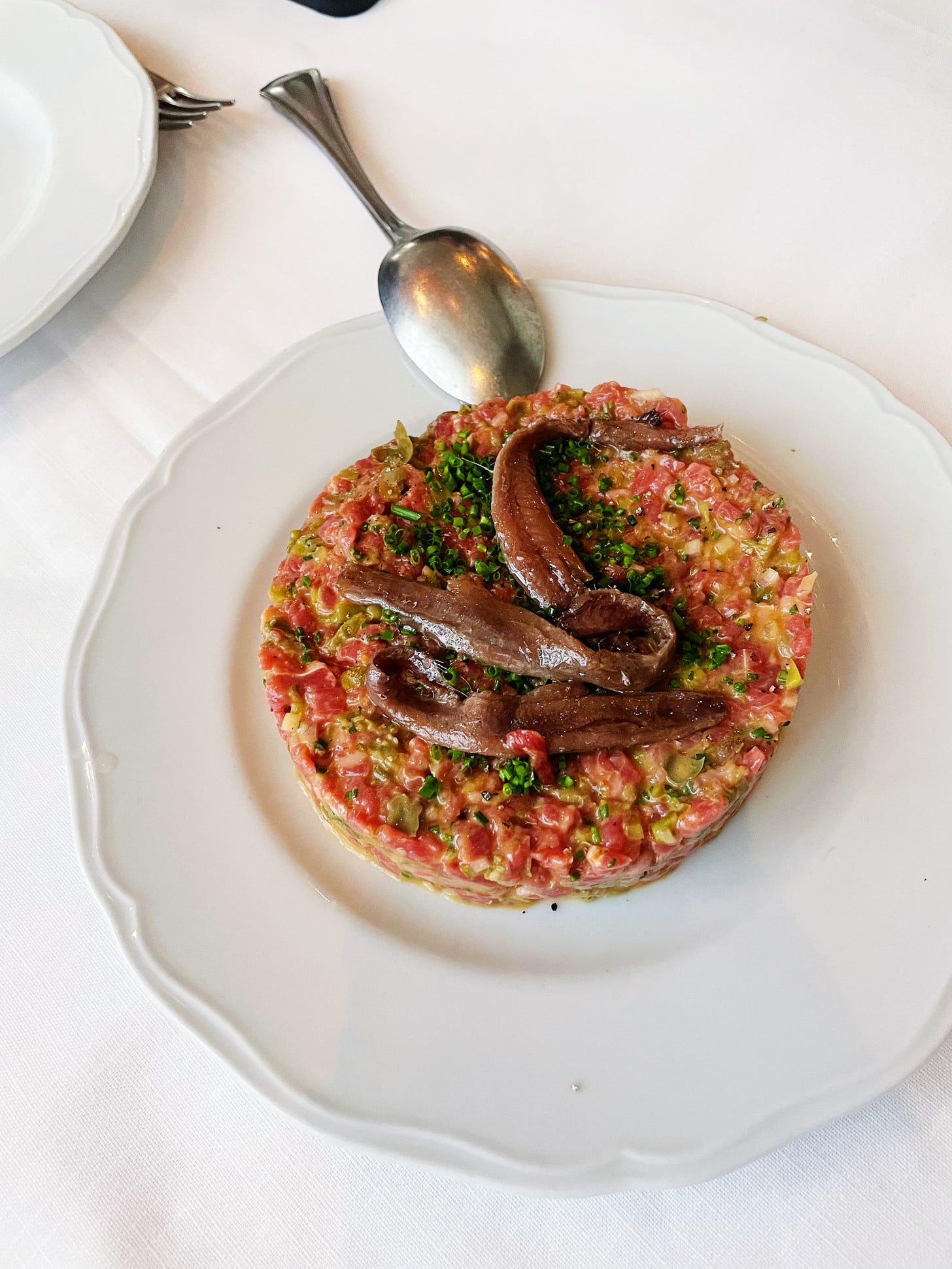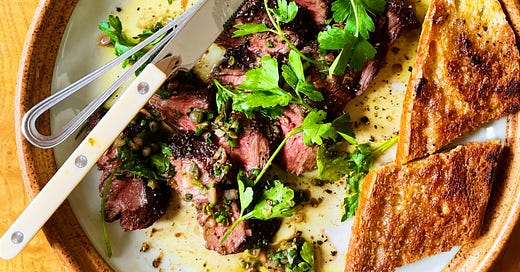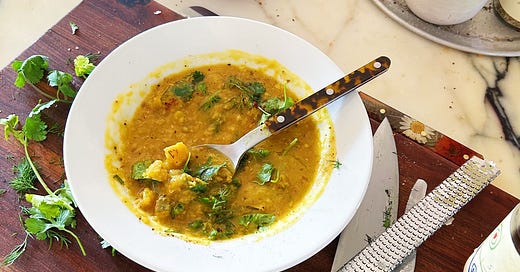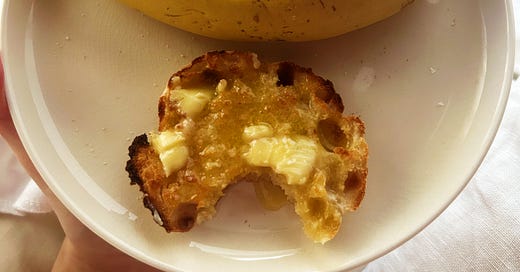Welcome to A Newsletter! Thank you for being here. If you’ve found your way over by some miracle but are not yet subscribed, let me help you with that:
When I was on book tour for two months (three countries, twelve cities), I ate at many restaurants. One might say too many restaurants? (I would say that!). The in-exhaustive trend report is: small bowls of creamy dairy (ricotta, feta, labe) still reign supreme as a snack or side, anchovies laid out on a plate or large puffy piece of bread or crispy griddled toast with or without butter (I shouldn’t complain, but), and: steak tartare. Mostly steak tartare, actually— I’d say that in my time away, I had about 23 versions of it, it was really on every menu of every style of restaurant. This is because sure, I love tartare (I’ll always order it— like a margarita pizza, I find it to be a good barometer of the restaurants efforts), but also it was inescapable. Most of them were great, a few were okay, one I didn’t love, but who cares, even a subpar tartare sends me to a good place, emotionally.
There were traditional steak tartares with Worcestershire and shallot, a tartare with beets instead of beef (get it?), tartare with venison, tartare with kangaroo. There was a table side tartare (I do love a spectacle), tartare with egg yolk, tartare without. Tartare with texture added (shoestring potatoes, fermented radish, caper berries), hand chopped tartare, tartare put through a meat grinder. Under-seasoned tartare which, if I’m giving the benefit of the doubt was because they really wanted me to “taste the meat,” and tartare that was too salty that I really did still love because I eat salt like it’s popcorn. Tartare, though some may say never died, is officially born again.

Anyway, I’m not a restaurant critic and I’m not here to grade the tartares (though I have always envied the newspaper/magazine restaurant critics of the 90’s and early aughts— reviewing restaurants for a dedicated audience in a pre-iPhone/TikTok/food blog era must have been a lot of fun. For great “food writing,” inspiration, that’s an interesting era/category to peruse). But I am here to say while it in and of itself goes on my list of “things I love to order but do not make at home because I do not know how or I do not want to”, the ingredients that make the most traditional and basic versions are undeniably ME, and I use them OFTEN. Shallot, anchovy, capers, chives, Worcestershire. An AR ingredient starter pack if there ever was one.
So that’s how we got here, Steak Like Tartare. Not far from my usual way to eat steak in the summer on my small little patio (seared, served rare, covered in some sort of herby sauce with anchovies on the side if there are extra), but doctored to really hit the tartare spot in a way that I can confidently say might be my favorite thing to eat with steak to date. Add hot sauce or horseradish if you want— those are not mandatory in my steak tartare, but I respect it if they are in yours.
Whatever steak you choose is sort of secondary here— you can go with whatever cut you usually like— but I do recommend something “beefy,” in flavor, like a boneless short rib (which tends to require a finish in a low oven since it’s so thick) or quick-cooking, affordable but harder to find hanger steak. If you don’t do beef, I would confidently say this sauce would still be great with pork, lamb or chicken. If you don’t do meat, eat it with crisped, roasted mushrooms. If you don’t do anchovies, don’t talk to me! Kidding! But honestly, leave them out I guess, just please never tell me about it.
Steak Like Tartare
serves 4
Not far from my usual way to eat steak in the summer (seared, served rare, covered in some sort of herby sauce with anchovies on the side), but doctored to really evoke “you’re eating steak tartare” (except the steak is, um, cooked). The ingredients stay classic– shallot, caper, chive, Worcestershire, and yes, anchovies. As for seasoning, you should adjust as you see fit– add hot sauce or horseradish if you want, more or less vinegar, you get the picture.
Whatever steak you choose is sort of secondary here— you can go with whatever cut you usually like— but I do recommend something “beefy,” in flavor, like a boneless short rib (which tends to require a finish in a low oven since it’s so thick) or quick-cooking, affordable but harder to find hanger steak. If you don’t do beef, I would confidently say this sauce would still be great with pork, lamb or chicken. If you don’t do meat, eat it with crisped, roasted mushrooms.
INGREDIENTS
1 ½ –2 pounds hanger steak (you can use any steak of your choosing, boneless or bone-in, such as ribeye, boneless short rib, sirloin, etc).
Kosher salt, freshly ground black pepper
2-3 tablespoons neutral oil, such as canola
1 medium or ½ large shallot, finely chopped
4 anchovies, finely chopped, plus more for serving if you’ve got them
2 tablespoons capers, finely chopped
2 tablespoons red or white wine vinegar, plus more
½ teaspoon Worcestershire sauce, plus more
½ cup finely chopped chives (scallion works in a pinch)
¼ cup parsley leaves, tender leaves and stems
¾ cup olive oil, plus more
Some sort of bread (baguette, sliced country loaf, ciabatta), halved lengthwise or sliced
1. Season steak with salt and pepper (do this ahead if you can, even if by 10-15 minutes or so).
2. Heat oil in a large skillet, preferably cast iron, over medium-high heat, swirling to coat the surface. Once the oil starts to shimmer, add steak (if using hanger steak, flat-side down; work if batches if needed to avoid crowding the pan), pressing it a bit with tongs to ensure good contact with the skillet (this is how you get even browning). For hanger steak, cook 4-5 minutes until deeply browned (thicker pieces of meat will take closer to 5–6). Using tongs, flip and cook for another 2-3 minutes until browned on that side as well.
3. Transfer steak to a plate to rest (a plate will catch their juices vs. a cutting board from which they’ll escape), leaving any meaty bits or rendered fat behind in the skillet.
4. While the steak rests, make the sauce(!). In a medium bowl, combine shallot, capers, anchovies, 2 tablespoons vinegar, ½ teaspoon Worcestershire, chives, and parsley. Stir in olive oil along with any meat juices from the plate the steak is resting on. Taste the sauce and season with more vinegar, Worcestershire, salt and pepper as needed. Steak Like Tartare seasoning (like tartare) is deeply personal and should be adjusted to suit you and your loved ones.
5. If you like, use the skillet with all the meaty bits to toast your bread for 2–4 minutes over medium heat until golden brown and crisp (add a little olive oil to the skillet if it needs it).
6. To serve, slice steak against the grain to create a more tender slice. Arrange steak on a large serving plate, spooning sauce over the steak. Scatter with more parsley if you’ve got it, serving with toast and more anchovies alongside.
DO AHEAD: You can season your steak a day ahead if you like– otherwise, this sauce is really best made when you’re planning on eating it. That said, it DOES make good leftovers, even as a quick dressing, spooned over lettuce the next day.




















Since our daughters are out of town, I'm going to celebrate Father's Day Sunday by making this for my wife and I. It looks to be fabulous!
This sounds pretty much perfect!!!! ❤️